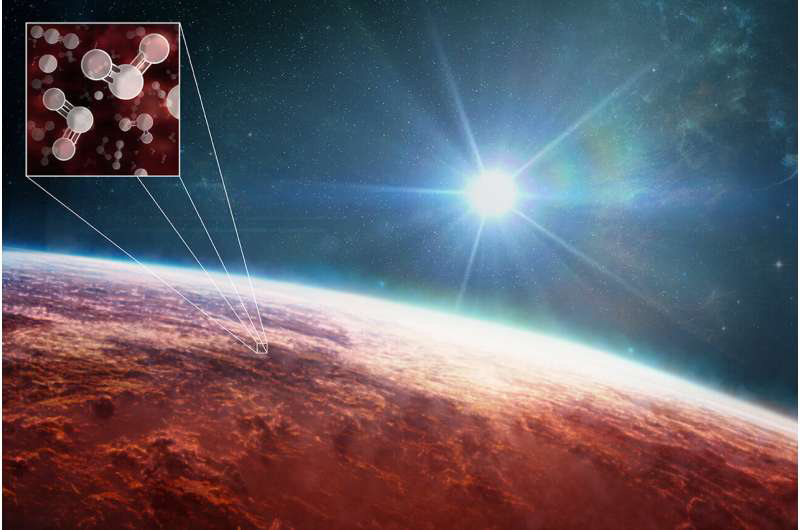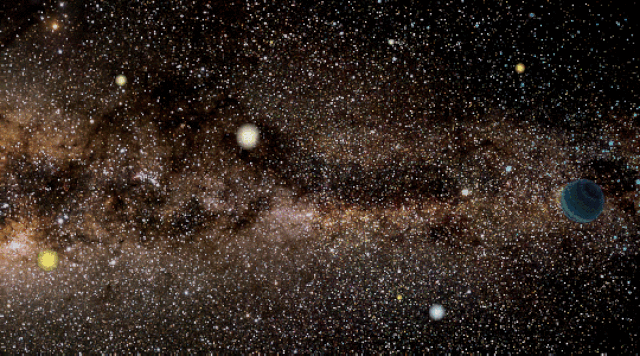Astronomers stunned by three Earth-sized planets orbiting two suns Science Daily - November 12, 2025
Three Earth-sized planets found orbiting both stars in TOI-2267 are rewriting the rules of planet formation. Remarkably, planets transit around both stars - a first in astronomy. The systemÕs compact, cold nature defies conventional theories of planetary formation. Future studies using JWST and other advanced telescopes could reveal what these worlds are truly made of.
Planet Y? Astronomers find fresh clues of hidden world in our solar system CNN - October 3, 2025

An illustration showing Planet Nine, a hypothetical, undiscovered planet in our solar system. New research now suggests the possibility of Planet Y, which would be smaller and orbiting closer to the sun than Planet Nine.
A new ring system discovered in our solar system PhysOrg - February 8, 2023
Scientists have discovered a new ring system around a dwarf planet on the edge of the solar system. The ring system orbits much further out than is typical for other ring systems, calling into question current theories of how ring systems are formed. The ring system is around a dwarf planet, named Quaoar, which is approximately half the size of Pluto and orbits the sun beyond Neptune.
This dwarf planet has a ring instead of a moon, and scientists don't know why CNN - February 8, 2023
Recent telescope data revealed that a small planet in the far reaches of our solar system has a dense ring round it. And scientists are baffled as to why. The planet, Quaoar, is one of roughly 3,000 small planets that orbit the sun beyond Neptune, and at 690 miles (1,110-kilometers) wide, it's about the seventh largest, with Pluto and Eris ranking as the biggest. Observations of Quaoar made between 2018 and 2021 revealed that the planet has a ring sitting farther away from it than scientists previously believed to be possible, according to a news release from the European Space Agency, which used ground-based telescopes and a new space-based telescope called Cheops to collect the data.
James Webb Space Telescope reveals an exoplanet atmosphere as never seen before PhysOrg - November 22, 2022

The James Webb Space Telescope (JWST) has just scored another first: a detailed molecular and chemical portrait of a distant world's skies.
An Earth-size planet is careening untethered through the galaxy Live Science - October 29, 2020

Earth orbits the sun like a ship sailing in circles around its anchor. But what if someone or something cut that ship loose? Unbound from any star or solar system, what would become of a tiny world flying helplessly and heedlessly through interstellar space? What happens when a planet goes rogue? Scientists suspect that billions of free-floating or "rogue" planets may exist in the Milky Way, but so far only a handful of candidates have turned up among the 4,000-or-so worlds discovered beyond our solar system. Most of these potential rogue planets appear to be enormous, measuring anywhere from two to 40 times the mass of Jupiter (one Jupiter is equivalent to about 300 Earths). But now, astronomers believe they've detected a rogue world like no other: a tiny, free-floating planet, roughly the mass of Earth, gallivanting through the gut of the Milky Way.
Scientists discover distant 'mirror image' of the Earth and the sun Science Tech Daily - June 7, 2020
The star Kepler-160 and its companion KOI-456.04 are more reminiscent of the Sun-Earth system than any previously known exoplanet-star pair. Among the more than 4,000 known exoplanets, KOI-456.04 is something special: less than twice the size of Earth, it orbits a Sun-like star. And it does so with a star-planet distance that could permit planetary surface temperatures conducive to life. The object was discovered by a team led by the Max Planck Institute for Solar System Research in Gttingen. Its host star, called Kepler-160, actually emits visible light; the central stars of almost all other exoplanets, on the other hand, emit infrared radiation, are smaller and fainter than the Sun and therefore belong to the class of red dwarf stars.
This Newfound Alien Planet Has 3 Suns Space.com - July 27, 2019
Astronomers think they've spotted an alien planet with three suns on its horizon - but that still isn't the most interesting thing about the strange new world's sky. Scientists found the world, which they've dubbed LTT 1445Ab, in data gathered by NASA's Transiting Exoplanet Survey Satellite (TESS). LTT 1445Ab orbits just one of the three stars, all of which are red dwarfs in the latter half of their lives, and the system is about 22.5 light-years away from Earth.